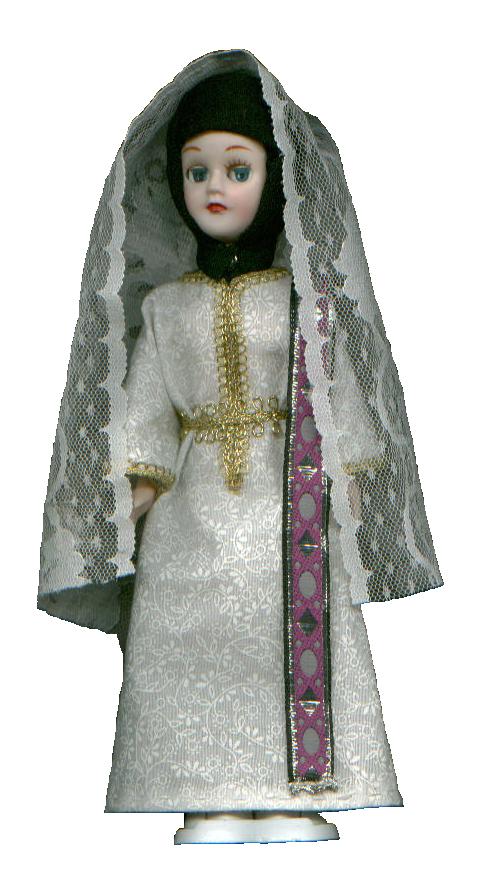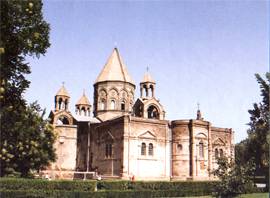
|
|
Tell a friend Bookmark Us Contact Us
Deaconess, Constantinople, 19th Century.The dress of a deaconess serving in the
Armenian Apostolic Church. The deaconess wears an orarion and fine, silver-wrought veil.Source: "History of the Armenian Church" by G. Mesrop.

The Armenian Church, also known as the Armenian Apostolic Church,
is an independent Christian church embracing the majority of the
Armenian people.
Armenian Apostolic Church is the world's most ancient Christian
community. It was founded by apostles St. Thaddeus and St.
Bartholomew. The apostle Thaddeus (35 to 43 A.D.) was preaching
in Southern Armenia, and Bartholomew, (44 to 60 A.D.) was preaching
in the North. Both were to be persecuted and martyred. The Cathedral
of St. Thaddeus, built in the 6th Century, still stands over his
tombstone in the Northwestern region of Iran near Tabriz. In the
cathedral there are chapels in the name of the Virgin Sandoukht,
daughter of King Sanatrouk, who during the early days of Christendom
had accepted the new faith, but later, due to political pressure
denied it, contrary to his daughter who remained steadfast and
was executed by her own father.
Saint Gregory Illuminator was chosen as the head of the Armenian Church,
and a cathedral was erected at Etchmiadzin (near Yerevan in Armenia) in
303 A.D. Echmiadzin means The coming of the only Begotten because it was
built where people said Jesus Himself descended from heaven to show where
He wanted a church built.
Since the 5th century the Armenian church has embraced Monophysitism,
a doctrine that states that Christ has a single human and divine nature.
Adherence to Monophysitism has kept the Armenian church separated from
other Christian churches.
Early in the fifth century A.D., Saint Mesrop, also known as Mashtots,
devised the alphabet for the Armenian language, and religious and
historical works began to appear as part of the effort to consolidate
the influence of Christianity. For the next two centuries, political
unrest paralleled the exceptional development of literary and religious
life that became known as the first golden age of Armenia.
Throughout its history Armenia has been overrun by invaders and has been
looted and ravaged many times. Its wealth was confiscated, its women and
nobility enslaved. Its lands were occupied either partially or wholly,
its territories partitioned among other powers. Yet after each subjugation
Armenia rebuilt its devastated country and regained independence or autonomy.
Assyria, Babylonia, the Medes, Achamenid Persia, Alexander the Great,
the Romans, the Byzantines, Arabs, Seljuks and Turks invaded Armenia;
but none was able to crush the independent spirit of the people.
During World War I, following the 1915 Turkish Genocide of Armenians in Western
Armenia, many Armenians fled to the eastern regions of Armenia. Some
survivors were able to flee to other lands. In 1920 the Soviet Republic
of Armenia was formed on the remaining one tenth part of Historical
Armenia, with Yerevan as its capital. Armenia is now an independent
state situated between Muslim Turkey, Iran, and Azerbaijan, and
partially Muslim Georgia.
The liturgical language of the Church is classical Armenian.
As Armenians fled the Turkish massacres and found refuge in all
corners of the world, today there are Armenian churches in every continent.
Background courtesy of www.cilicia.com, edited by G.G.M.
HISTORY
Many converts to Christianity were made in Armenia through the first,
second, and third centuries after Christ. The number of Christians
grew rapidly among the people. When Trdat (Tiridates) III took over
the throne in 287 A.D., a fresh wave of persecutions started. Later
in 301, St. Gregory the Illuminator formally established the Church
in Armenia, and King Trdat III was baptized, and he declared Christianity
as the state religion. Armenia became the first nation to adopt Christianity
as a state religion. However, Christianity was ushered into Armenia by the
people rather -the rulers.

in Vaspurakan. After Apostal's
martyrdom his body is believed
to have been interred here.
Since then the Cathedral has been the ecclesiastical metropolis of the
Armenian nation. It is said to be the oldest monastic foundation in
the Christian world.
